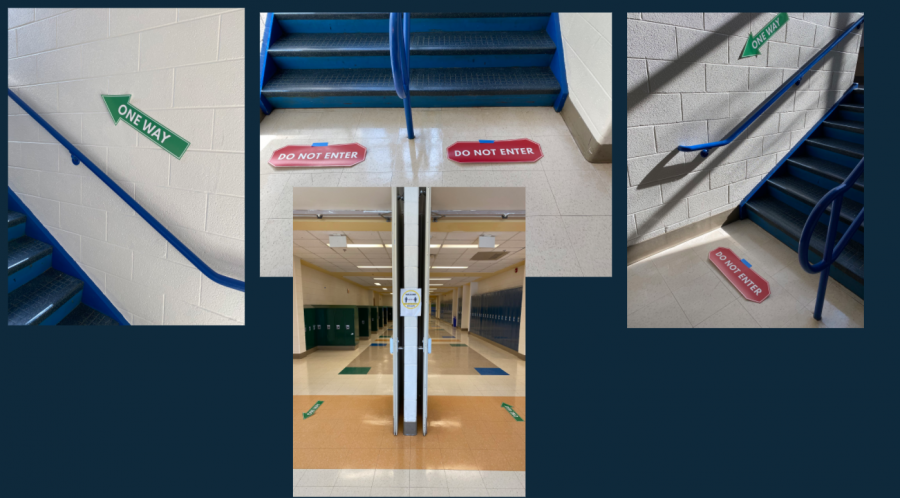Returning to school poses a greater risk than reward
Photo Courtesy of Ms. Heckert’s PTSA meeting slideshow
The hallways and stairwells of WCHS have been marked with arrows to guide students and staff in the safest manner possible when reopening begins.
March 8, 2021
COVID-19 continues to unleash its wrath upon the globe, affecting millions of jobs and the education of our youth. One year has passed since the start of the country’s fight with the pandemic, marking nine months of virtual education for students. Mayors and governors are beginning to finalize hybrid learning plans for the spring semester, but will it really be any different than students have it now? The complicated schedule for return to in-person instruction is not even guaranteed, and if it becomes reality, it will only serve purpose in confusing students, staff and parents about how everyone will make a safe return to school with minimum impact on the quality of our education.
According to Johns Hopkins University, as of Feb. 20, 2020, Montgomery County COVID-19 hospitalizations have dropped below 1,000 since November, at a number of 763 cases. As long as cases keep decreasing, Jack Smith, the superintendent’s, plan to reopen schools starting Mar. 1 is still on target.
Parents of WCHS students were provided the opportunity to choose whether they wanted their kids in school or to continue with virtual instruction via a survey. The results from the survey conclude that 34.8 percent of parents do not want their children going back to school.
According to the information released by the Board of Education about their meeting on Feb. 9, 2020, Montgomery County Public School employees have the option of requesting an accommodation or leave under state and federal law, aligned with the Center for Disease Control and Prevention guidelines for underlying medical conditions.
This means that even if students were to go back to school, there would be a chance that their teachers would be giving instruction through Zoom, which is not any different than the virtual education program now. The only difference being that students would have to go into the building to be taught on Zoom.
On Feb. 16, 2020, the PTSA had an informatory meeting about the details of returning to school.
Bus drop off for students who require bus transportation would occur at 7:45 a.m., even though instruction begins at 9 a.m. after focused student intervention. However, it seems as though students who do not need transportation provided by the school can arrive at 9 a.m. without having to be present during focused student intervention.
Going back to the building means being in an enclosed space for multiple hours of the day. Students who have to get to school over an hour earlier just to get transportation to school puts them at a higher risk of being potentially exposed to the virus.
To make returning as safe as possible, Montgomery County has assigned specific grades to phases that go back to school on different dates. Teachers and staff will have to manage instruction for in-person classes as well as students who will remain in the virtual classroom. The real question is whether or not virtual or in-person students will have an advantage over one another.
The safety guidelines set up by the school are nothing but restrictive. Students must remain in their classrooms under the supervision of classroom monitors who specifically watch over the transitions between classes, morning arrival, dismissal, lunch and extra classroom coverage.
Lunch can only be eaten in the auxiliary gym, designated classrooms and the cafeteria. Students will be prohibited from leaving for lunch or ordering food. Desks are set up according to the six foot separation guidelines, separating students from interaction.
Almost like going back to elementary school, students are allowed minimal freedom and independence without supervision from an administrator or staff. Only two bathrooms will be available, and it is still unknown if students can walk around in the hallways. The health of everyone participating in the reopening of schools is the number one priority.
Everyone is used to being at home in their own comfort. Breaks between classes and a long lunch period allow students to get food, leave the house or run errands. Returning back to school takes away the independence of doing whatever and going wherever you can.
Reopening when there is still a chance that cases can rise is a huge risk. There is no way to track where people go or who they come in contact with at all times of the day.
While many teachers will be protected by the vaccine, most students will not have that opportunity and the feeling of safety that comes with it. There are many alternatives for safe options for reopening, and waiting for both students and staff to be vaccinated is the best way to protect our friends, family and loved ones at home.


